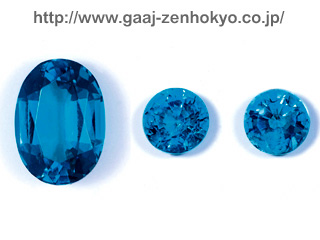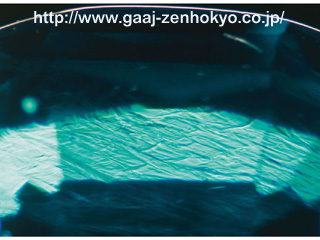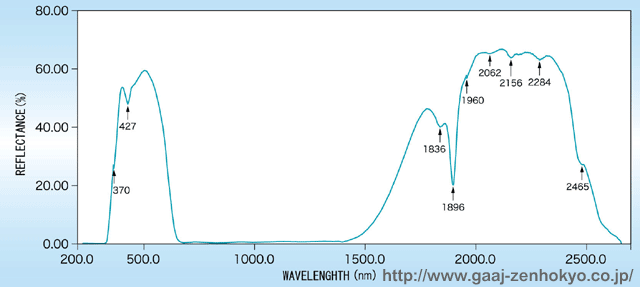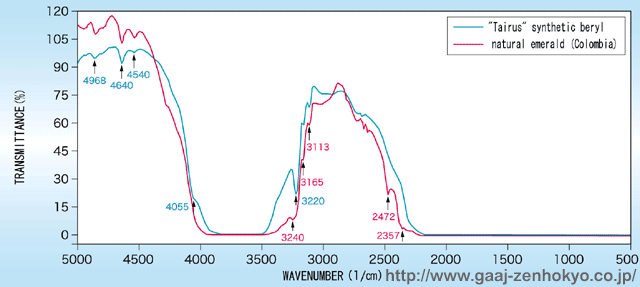|
||||||||||||||||||||||||
We recently encountered stones for identification, which were showing the colour of Paraíba tourmaline (photo 1). After our tests, they proved to be synthetic beryl containing high concentration of Cu. Further investigations later revealed that similar synthetic beryl have been produced by Tairus Created Gems Co., Ltd. in Russia. The background and gemmological features of the material is introduced here. In September 2007, Tairus Created Gems Co., Ltd. announced a new product under the commercial names gSynthetic Paraíbah or gSynthetic beryl in Paraíba colourh at the Gem & Jewellery show in Bangkok. The company, based in Novosibirsk, Russia, is the world largest manufacturer of synthetic stones (G. Choudhary et. al., winter-2007 Gems & Gemology, pp 385-387). As Paraíba tourmaline becomes popular in the market recently, natural stones such as beryl and apatite or artificial glass in similar colour become more in use as substitute goods. The gTairush synthetic beryl that is introduced here seems to have similar background for its demand. The synthetic beryl we had an opportunity to identify this time were three pieces of green-blue transparent fancy-cut stones in the size of 0.744, 0.277 and 0.274 carats (photo 1), in which we could easily observe gchevronh or gjaggedh growth patterns that were characteristic features of hydrothermal synthesis under magnification with a gemmological microscope (photo 2).
These growth structures, similar to the synthetic emerald coloured by V and a trace of Cu that are created by the same company, are assumedly due to irregular granular boundaries (K. Schmetzer et al., Journal of Gemmology, vol.30 No1/2 2006, pp59-74). They displayed distinct dichroism of yellow-green / green-blue under a pleochroism test, and their RI ranged 1.583-1.590 that were abnormally high values for synthetic beryl. Traditional hydrothermally-grown synthetic emerald (produced by USSR, Biron in Australia, Malossi in Czech and Linde-Regency in the USA) and natural emerald from Colombia usually show RI range 1.57`1.58. SG of the new material was around 2.74, which was also higher than the traditional synthetic beryl. This is presumably caused by high concentration of Cu and Fe (iron). No characteristic absorption was recognised under a hand-held spectroscope, and they were inert under LW and SWUV lights in fluorescence test. Actual measurement using oxides in compositional analysis by EDXRF detected Ti, V, Cr, Fe, Ni and Cu, other than the major elements in beryl, Al and Si (Be is undetectable). The elements such as Ti, V, Cr and Ni showed lower concentration under 0.1 wt%, but the test proved that higher contents of Fe (over 3 wt%) and Cu (over 7 wt%) were included. Such beryl containing Cu and Fe in high concentration has never been confirmed in any variety of synthetic beryl that have been produced since the Tairus Created Gems Co., Ltd. was established in 1989, therefore this material is probably a newly commercialised production. In UV-Vis-NIR (200`2700 nm) spectral analysis, noted colouring transition metal elements were Fe and Cu, and the absorption at 370 and 430 nm originated in Fe3+ distributed in octahedral site in beryl structure, and the strong absorption band between 650`1200 nm originated in Cu2+ distributed in tetrahedral site. In NIR region, absorption due to H2O and hydroxyl were seen on 1200`1400 nm,1836, 1896, 2062, 2156, 2284 and 2460 nm (figure 1).
The spectrum of broad absorption at 2460 nm (4055 cm-1) with a shoulder is also detected in synthetic stones of aquamarine, beryl or emerald, and this can be an aid to distinguish them from natural emerald from Colombia, Brazil and Africa. The infrared spectrum in the range between 400`5000 cm-1 by FTIR closely resembled that of natural emerald, showing general absorption under 2200 cm-1 and a broad absorption between 3500`4000 cm-1, as well as sharp absorption lines at 3220, 3161 or 3111 cm-1. Absorption centred at 3240 and 2357 cm-1, that were commonly seen in natural emerald, were not recognised this time in the gTairush synthetic beryl containing Cu and Fe, instead, an absorption at 3220 cm-1, which was not seen in natural beryl, was detected (figure 2 and 3). These results can be guidelines for identification of synthetic beryl.
For further information, please contact: GAAJ-ZENHOKYO Laboratory E-mail: ahmadjan@gaaj-zenhokyo.co.jp Website: http://www.gaaj-zenhokyo.co.jp/index-e.html |
||||||||||||||||||||||||





